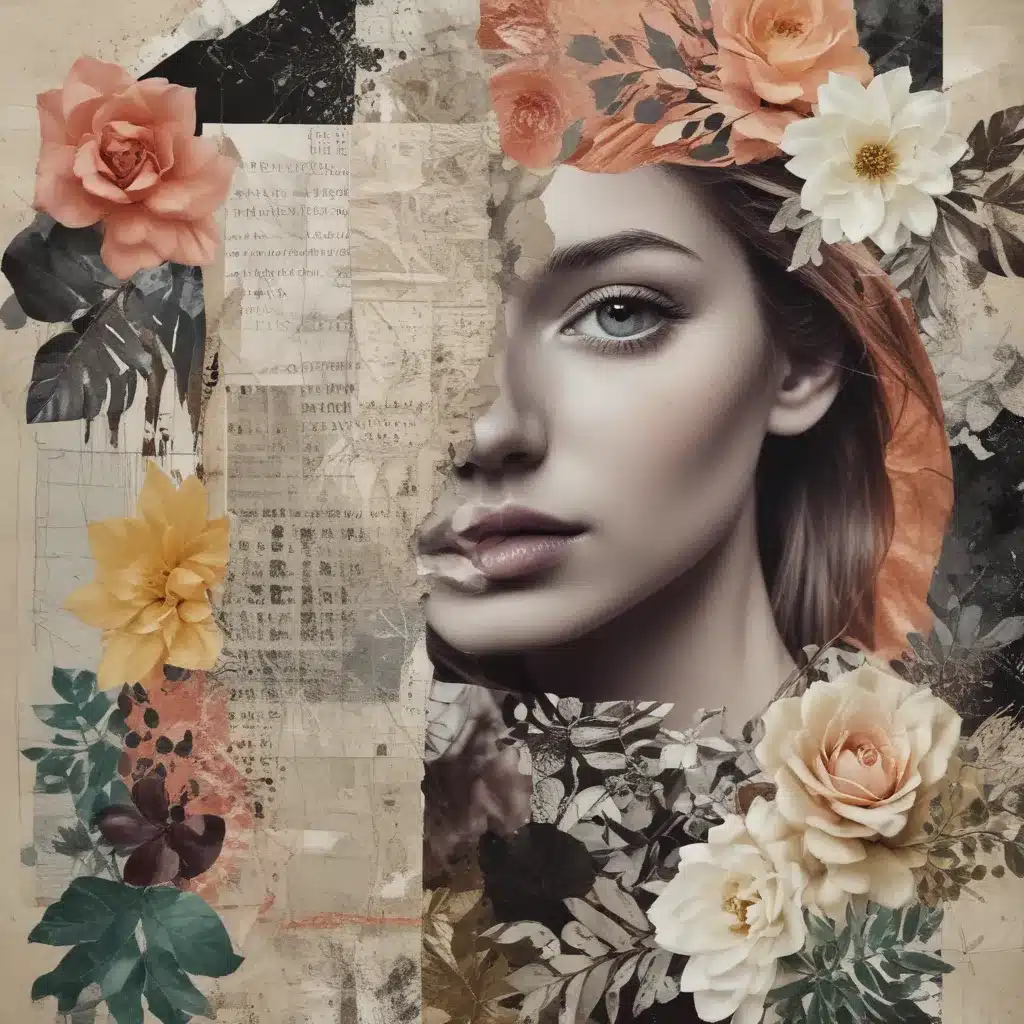
Collage has long been a beloved medium for artists seeking to push the boundaries of traditional art-making. By combining diverse materials, textures, and visual elements, collage artists can craft intricate compositions that captivate the senses and tell compelling stories. In the digital age, the art of collage has evolved, with contemporary designers and illustrators embracing the boundless possibilities of mixed media techniques and digital collage to create truly innovative work.
Now, this might seem counterintuitive…
Mastering Collage Compositions
At the heart of a successful collage lies a carefully crafted composition that harmoniously blends various elements. Whether you’re working with physical materials or digital assets, the principles of composition remain the same. The key is to thoughtfully arrange your chosen components in a way that guides the viewer’s eye and conveys your artistic vision.
Layering Textures:
One of the hallmarks of collage is the interplay of diverse textures. By incorporating a variety of materials, such as patterned napkins, handmade paper, fabric scraps, or found objects, you can add depth and visual interest to your compositions. Experiment with the placement and overlapping of these textural elements to create a sense of depth and dimension. Embrace the organic and unpredictable nature of collage, allowing the materials to inform the direction of your design.
Incorporating Imagery:
Collage provides an excellent platform for integrating diverse imagery, from photographic elements to hand-drawn illustrations. Carefully select and arrange these visual components to tell a story or evoke a particular mood. Consider the relationships between the different images and how they can be combined to create a cohesive narrative. Experiment with scale, orientation, and overlapping to achieve a dynamic and visually captivating composition.
Collage Assembly Methods:
The physical or digital assembly of your collage can also greatly influence the final outcome. In traditional collage, the process of cutting, tearing, and arranging materials by hand can lend a tactile and organic quality to the work. Conversely, digital collage allows for more precise manipulation and seamless integration of elements using software like Adobe Photoshop or Procreate. Regardless of the approach, be mindful of the cohesiveness of your composition and the way the various elements interact with one another.
Painting and Drawing Techniques
Collage is not limited to the assemblage of found materials; it can also be seamlessly integrated with other artistic mediums, such as painting and drawing. By incorporating these techniques, you can add depth, texture, and visual richness to your collage compositions.
Modern Painting Techniques:
Explore the versatility of acrylic painting and watercolor to enhance your collage work. Acrylic paints offer a wide range of application methods, from bold, expressive brushstrokes to delicate washes, allowing you to create dynamic backgrounds or integrate painted elements directly into your compositions. Watercolor, with its fluid and translucent nature, can be used to add ethereal layers, soft gradients, or unexpected bursts of color that interplay with the collaged elements.
Pencil Drawing Tutorials:
Incorporating pencil sketching and shading techniques can lend a sense of depth and realism to your collage compositions. Use pencils to create detailed drawings, capture the essence of found objects, or add expressive linework that complements the collaged elements. Experiment with various pencil types, from hard graphite to soft charcoal, to achieve a range of marks and textures that enhance the overall visual impact of your work.
Artistic Design Principles
Mastering the technical aspects of collage is just one piece of the puzzle. To create truly captivating compositions, it’s essential to understand and apply key design principles that elevate the visual impact of your work.
Composition and Layout:
The arrangement of elements within your collage is crucial for guiding the viewer’s eye and creating a harmonious, balanced design. Explore concepts of balance and harmony, where the placement and scale of your components work together to form a cohesive whole. Experiment with rhythm and movement to add a sense of dynamism and energy to your compositions, leading the viewer’s gaze through the piece.
Color Theory:
Color is a powerful tool in collage, capable of evoking emotion, setting the mood, and unifying your design. Familiarize yourself with complementary color relationships and how they can create visual tension or harmony. Observe how different color palettes can influence the overall mood and emotion conveyed by your collage, and use this knowledge to enhance the narrative and impact of your work.
Creative Inspiration:
Collage is a medium that thrives on exploration and serendipity. Embrace the process of found object discovery, allowing yourself to be inspired by the unique textures, patterns, and imagery that you encounter in your daily life. Nature can also serve as a profound source of inspiration, with its infinite variety of shapes, colors, and organic forms that can be seamlessly integrated into your collage compositions.
Unlocking Your Creative Potential
As you delve into the world of collage, remember that the true magic lies in the process of experimentation and the willingness to embrace the unexpected. Approach each collage as an opportunity to push the boundaries of your artistic expression, to tell a story, or to simply tap into the pure joy of creating. Immerse yourself in the tactile or digital experience, and allow the interplay of textures, imagery, and design principles to guide you on an exhilarating creative journey.
Collage is a medium that celebrates the beauty of the imperfect, the unexpected, and the uniquely personal. By layering textures, incorporating diverse imagery, and applying key design principles, you can craft collage compositions that captivate the senses and leave a lasting impression. Embark on this artistic adventure with an open mind, a willingness to experiment, and a deep appreciation for the power of visual storytelling. The possibilities are endless.
Example: Modern Abstract Painting Series 2024